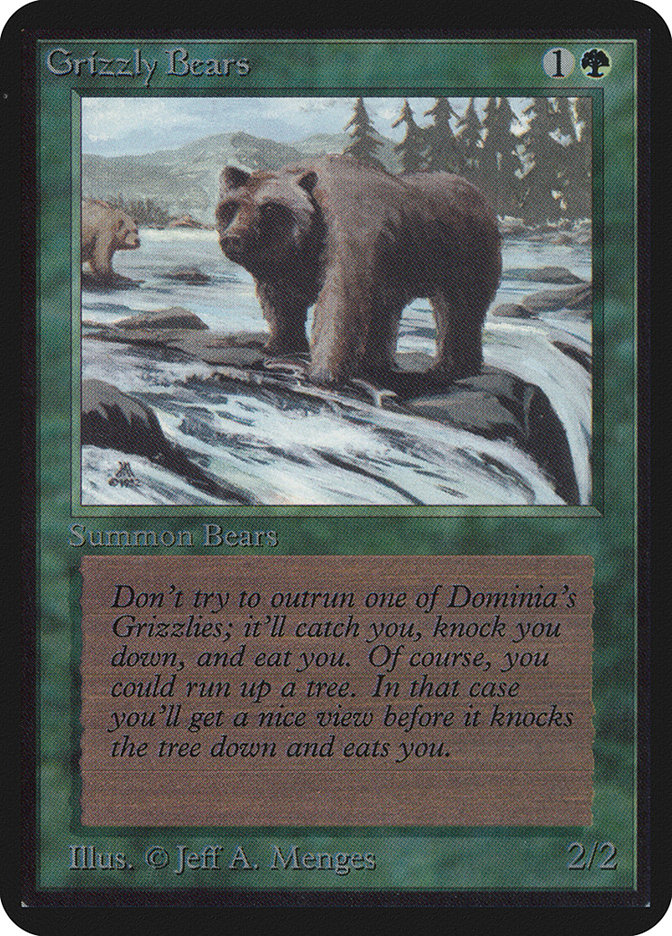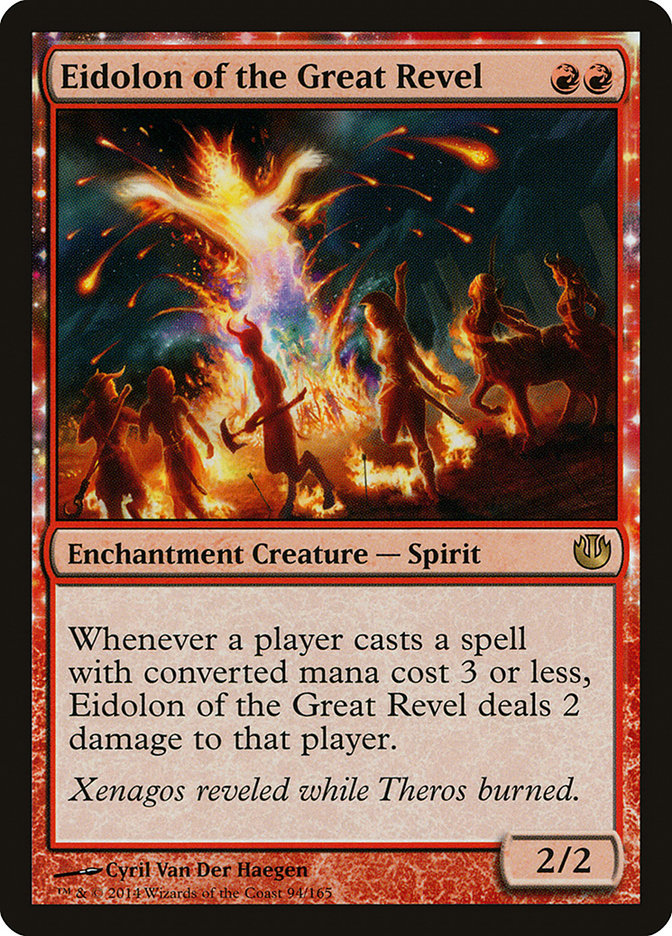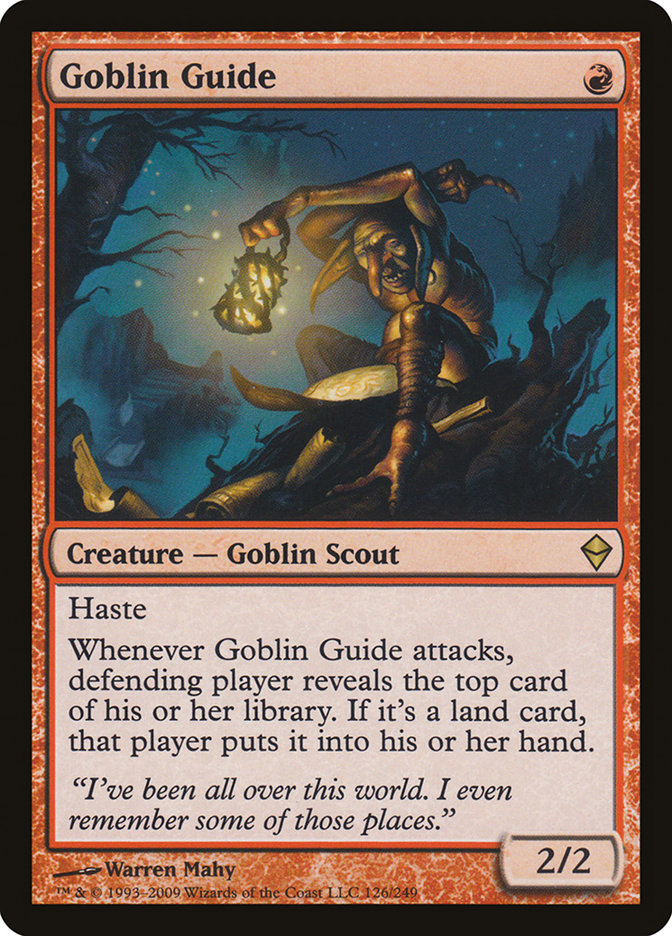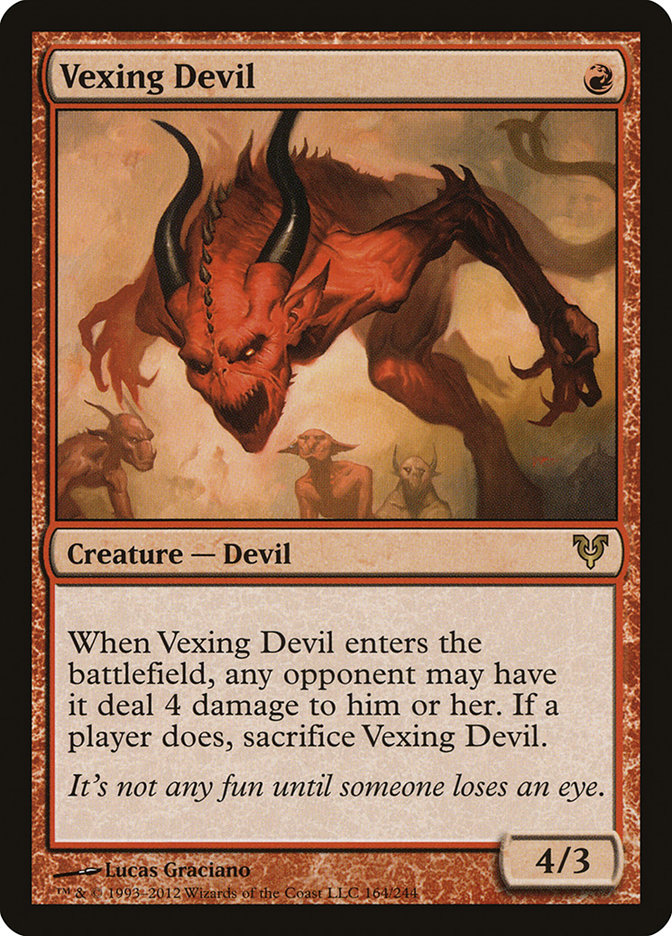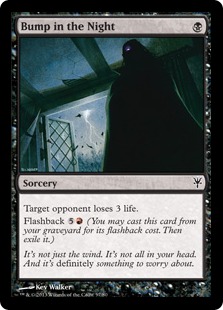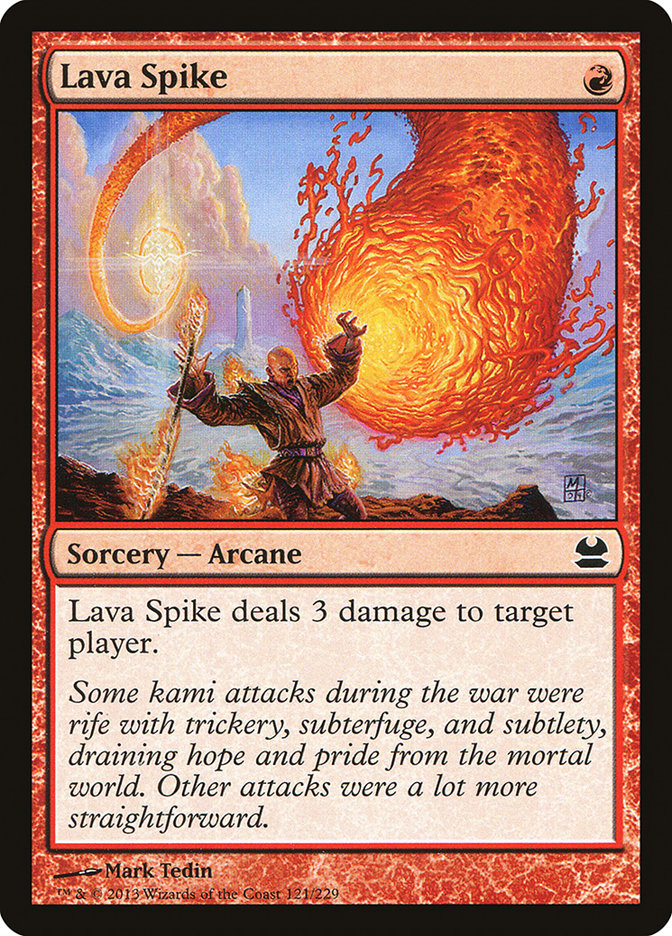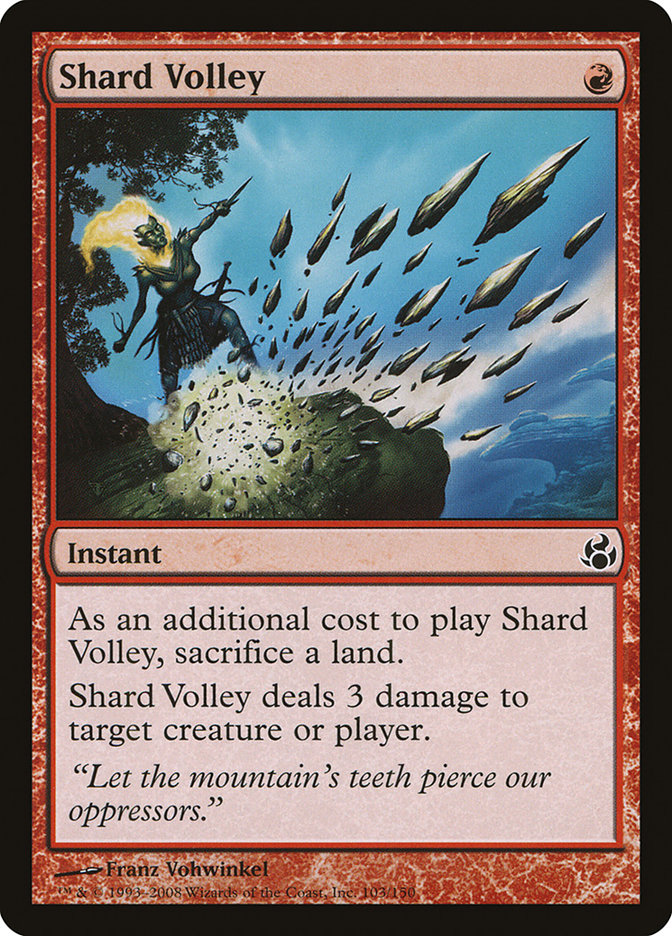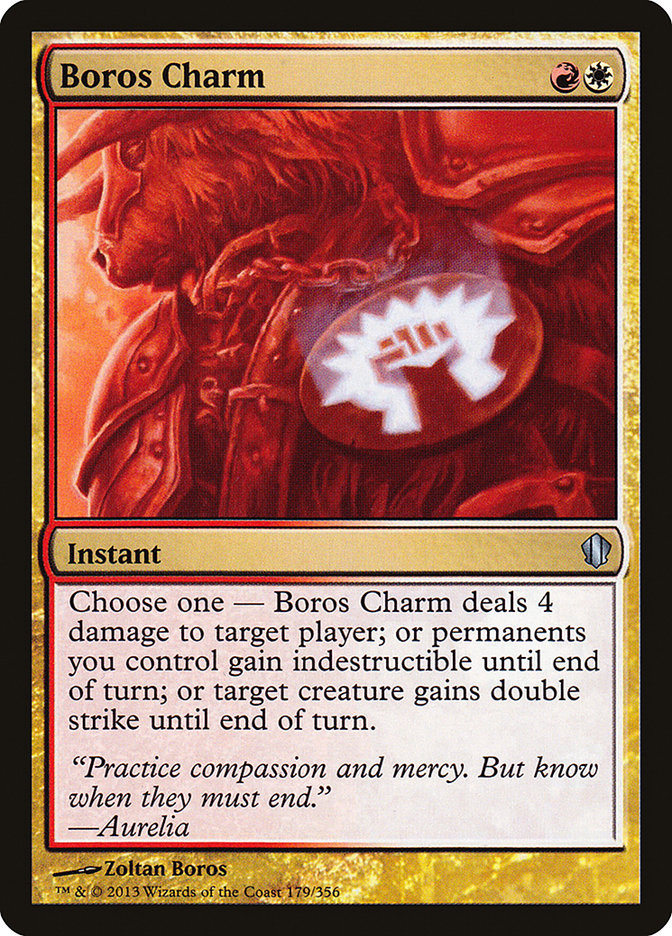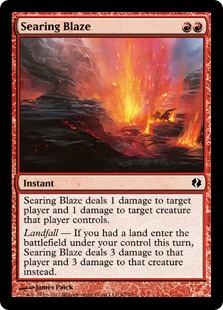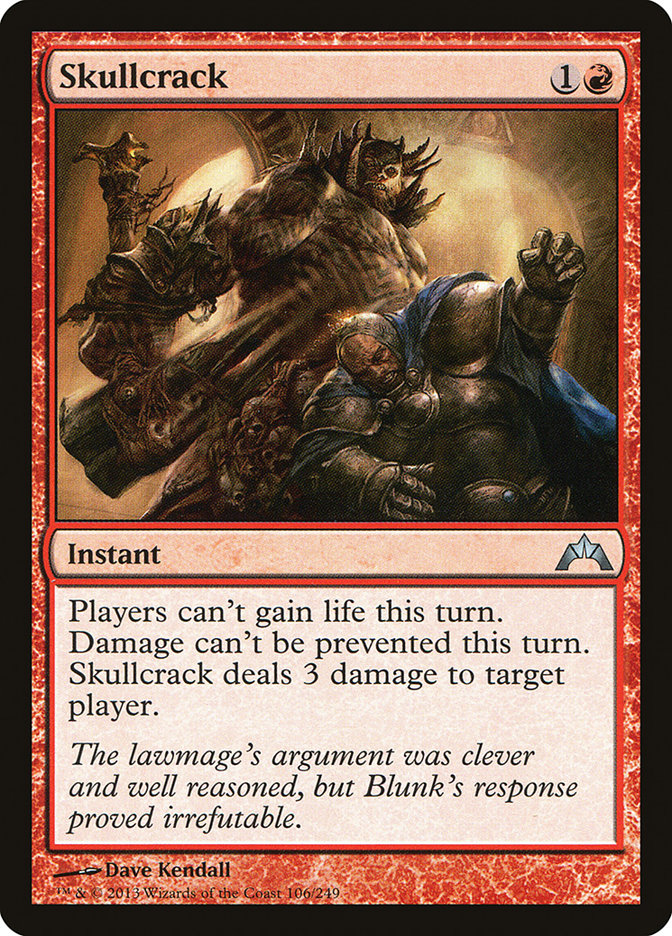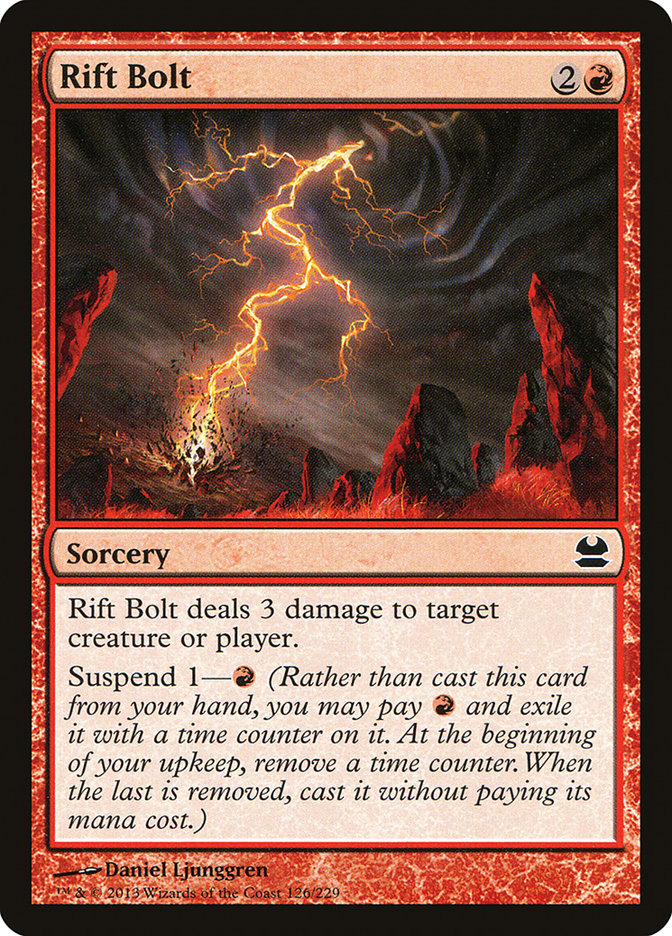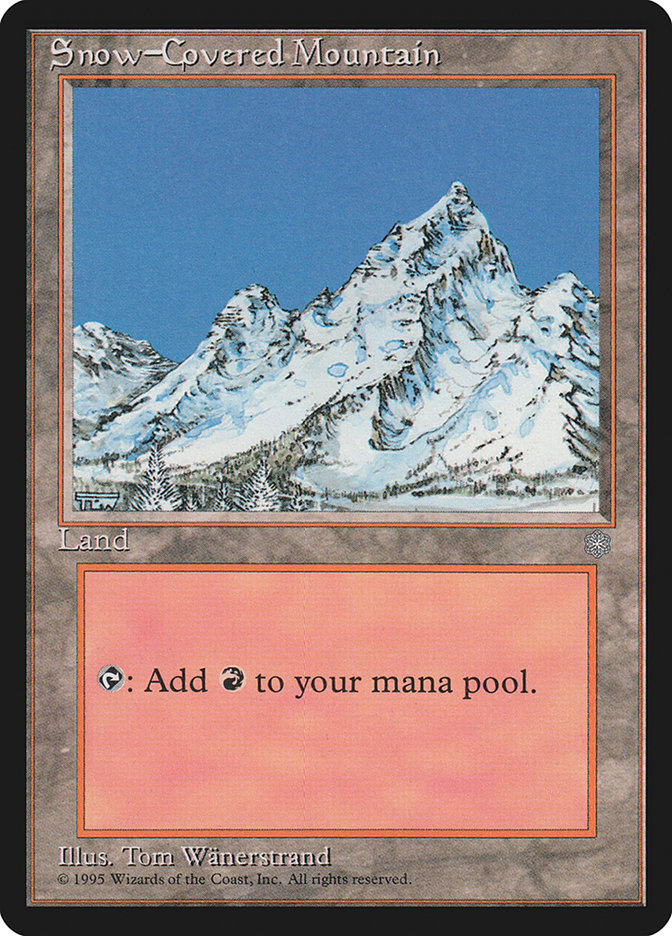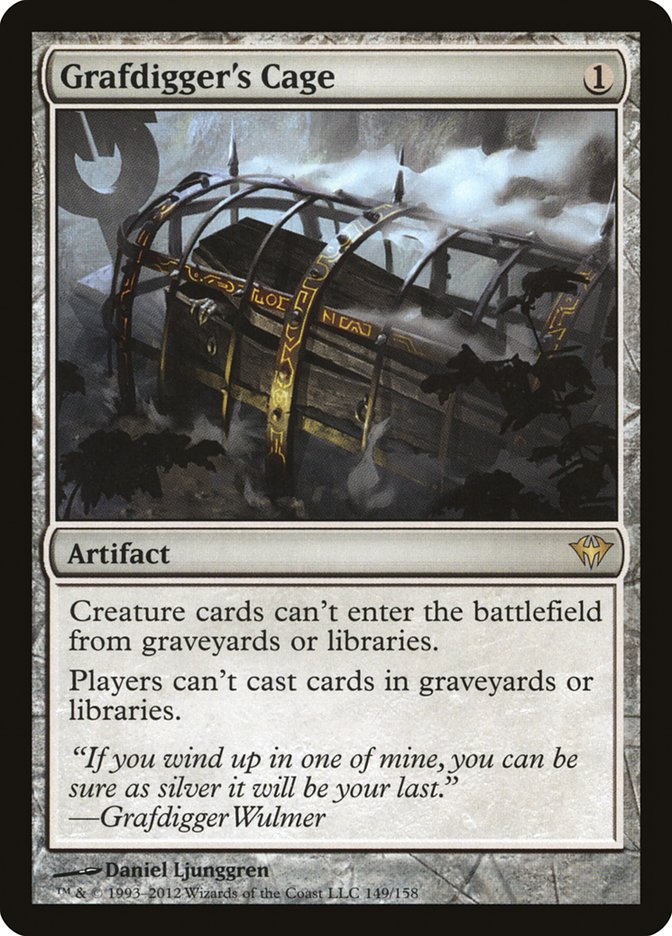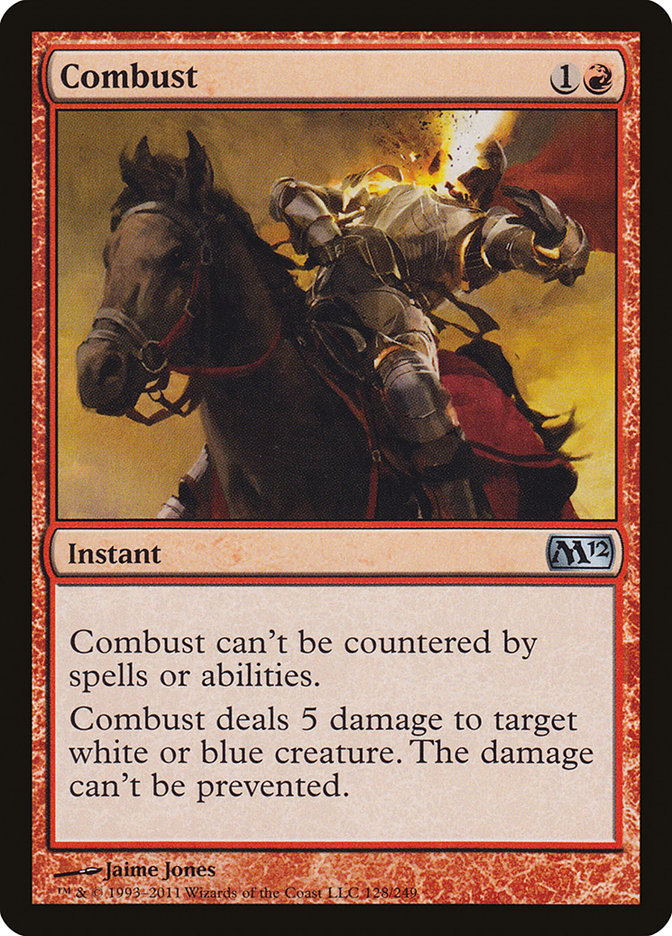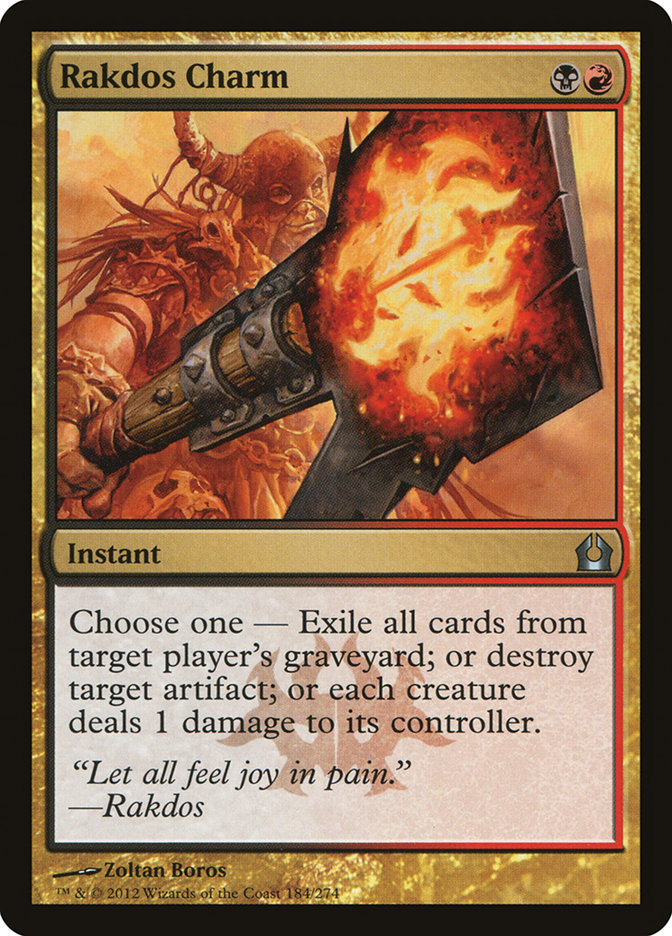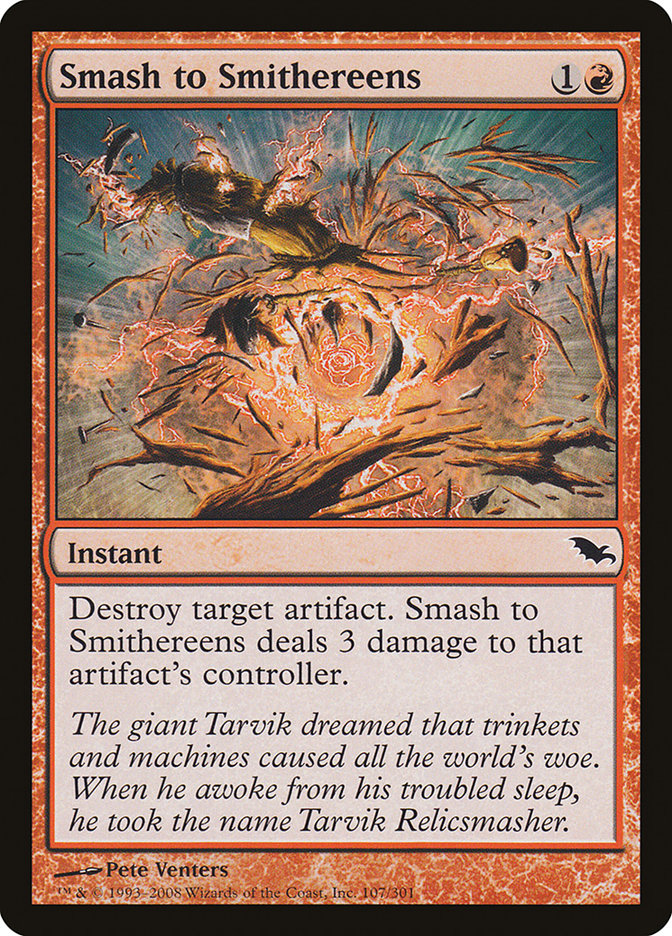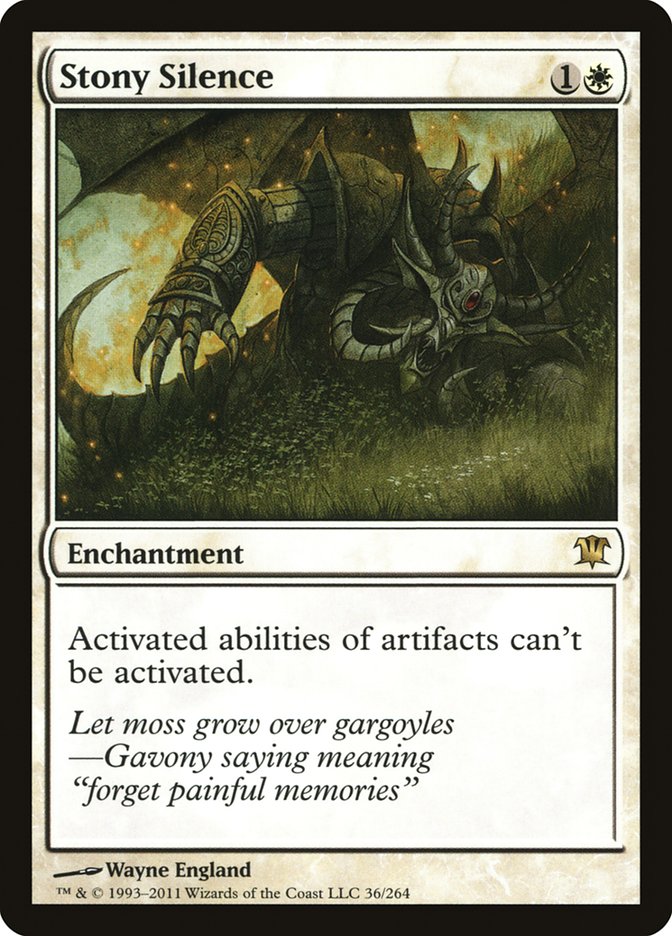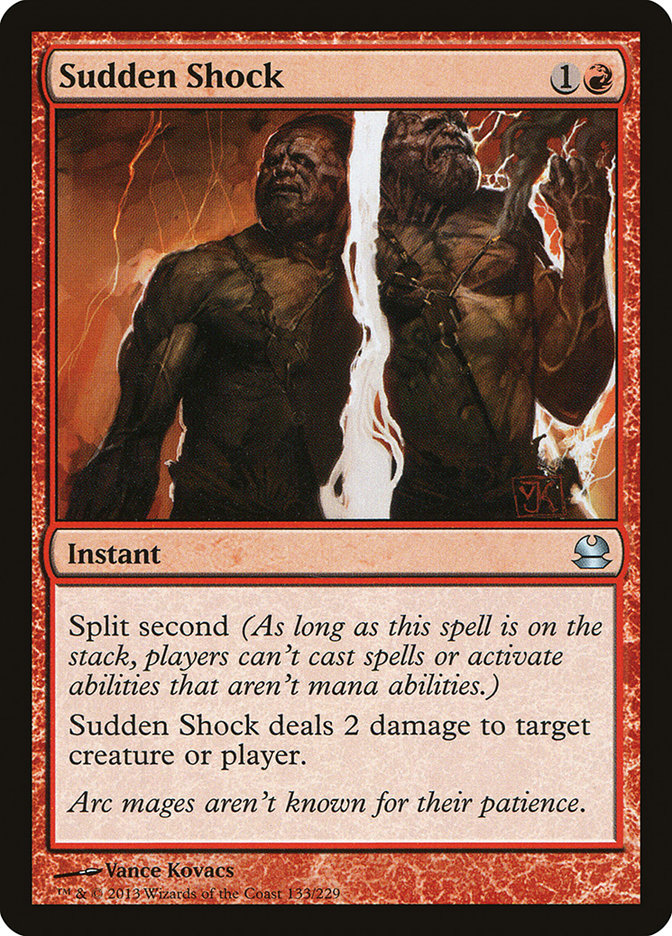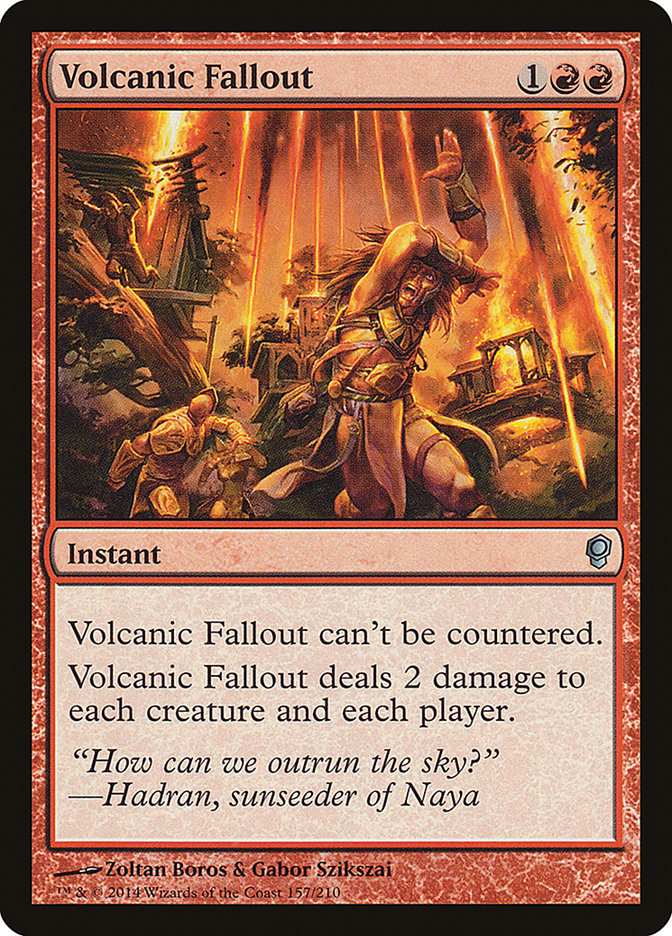
Hello, glad you could make it. I’m Jasper from Madison, Wisconsin, and I love playing with fire. Though I stray and shuffle up other colors when they
appear to provide a superior opportunity to win in a given format (sadly quite frequently), I am a red mage at heart, so I relish every opportunity to
break out the Grim Lavamancers and burn down the house. As such, I’ve been having a blast casting Lightning Bolt in Modern since the format’s inception,
most of the time alongside partner-in-crime Bump in the Night and its cohort of imitators.
Recent addition Eidolon of the Great Revel has brought with it a large amount of enjoyable complexity plus a veritable fight club worth of
mostly-indiscriminate raw damage output. Who cares if I win at one life? I savor that kind of game, and I love the exhilaration of snatching victory in a
close contest by playing around exactly the right cards. Every decision is on the razor’s edge when following the Goblin Guide. The sequencing of lands and
spells–each slight maneuver is of utmost importance.
Many decks punish subtle piloting errors grievously, but the basic balancing of life totals is such a visceral experience; expending various amounts of
mana, cards, and life points to acquire various amounts of time (mana, cards) and with it, damage dealt, all the while struggling to avoid any wasted
opportunities and ensure the formula ends up producing a win. I enjoy fighting and clawing for exactingly optimized damage efficiency, and the Eidolon just
adds tremendously to the layers of potential winning lines.
– Can they kill it? If so, how?
– Which spells do they need to cast to win before I can sneak through the last few points?
– How much life can I afford to pay the Great Revel?
– Is casting other spells first warranted?
Pyrostatic Pillar is a strong card that frequently made it into my sideboards of yesteryear. When it became clear that Theros block would feature
enchantments, it was reprints of the Pillar and Sulfuric Vortex that I hoped for most. (So far) I haven’t seen any sign of the Vortex breaking into Modern,
but simply taking the Pillar’s ability and splicing on a set of Bear arms resulted in what is, in my estimation, a card at a competitive power level with any in the entire format. I’ll take it.
Have a look at my newfound friend here:
Come on, doesn’t that party animal simply exude joy? Don’t you want to be happy like that? ‘Course you do.
“Burn” in Modern, as I’ve known it, has undergone various evolutions over time. The core concepts have remained very much the same, but many of the
ingredients have been upgraded since I first played it to the GP Toronto 2012 top 16. Deathrite Shaman stuck around long enough to help me win a PTQ.
Later, Boros Charm and Skullcrack arrived and paved the way to a 7-2-1 (top 50) finish at Pro Tour Born of the Gods.
Though there’ve been a number of alterations made to my preferred build as the format has developed and cards have been released or banned, no iteration
has been nearly such a Revelation as the printing of the so-named Eidolon. Many matchups are profoundly shifted, as it must be answered. If not, Splinter
Twin decks just can’t really cast Serum Visions while remaining satisfied with their life choices. Abrupt Decay? Oh, you better believe that’s a paddlin’.
Using Snapcaster Mage will cost you a Fireblast. Even Affinity, when going second with a slow draw, might be made to take eight or choose not to vomit out
their whole hand on turn 2. Storm? Infect? Ha! Take all of the damages. Many Tron decks are running eight copies of Chromatic Sphere…
Is this real life or the Eidolon’s fever dream?
Basically every opposing operator must deal with a resolved Eidolon by taking time out of their schedule and a shot to the life total before they can
resume their normal business. Or they can try to tough it out and survive a few instances of Shock while sticking to their plan. Well, it usually doesn’t
take very long at all for either approach to succumb to the rest of the blast furnace. Speaking of, here’s the current supporting cast, coming off a recent
PTQ finals loss:
Creatures (15)
Lands (20)
Spells (25)

The main factors dictating this framework are pure mana-efficiency and damage output per card. The cards that aren’t represented with the full playset,
along with the most efficient available cards that didn’t make it into the list, all cost more mana and/or deal less damage than Boros Charm and Bump in
the Night, or have other important limitations. Nothing is worse than having cards stranded in hand. Sporting fourteen and thirteen sources of black and
white mana, respectively, I haven’t regretted splashing those two main deck playsets at all, and Rakdos Charm is close to worth the additional color for
just its two copies.
I’ll comment on each of the card choices:
Letting opponents draw cards isn’t a historically great ability to utilize, but it’s a small price to pay overall for such beastly damage potential. An
unassuming, bumbling Goblin, but don’t let it fool you–this is who you should go to for all your first-turn needs. Starting fewer than four Guides is a
mistake, though it’s sometimes correct to board them out (along with at least the Vexing Devil) to attempt to invalidate blockers.
It can poke for one point at a time if resources need to go elsewhere, but this card sitting active on the board changes so much of what an opponent is
able to do in this format. If they pass the turn instead of playing out their under-three toughness creatures to be gunned down, they’ll just get shocked
at the end step. It can enable blocking creatures with lifelink and killing the blocker to prevent the lifegain (here’s looking at ya,’ Wurmcoil Engine).
Shrinking opposing Tarmogoyfs while simply throwing Shocks at the opponent over the top of their blockers is a notable pastime. There are only three
because resources do get strained, and while providing fuel and red mana for a single Lavamancer shouldn’t be too taxing, having two in play usually isn’t
where you want to be. A fourth in the board would be applicable in some areas but hasn’t seemed better to me than the other options.
A controversial card to be sure, and I can understand the hate. The punisher mechanic has been featured on a lot of awful Magic cards, but the up-front
investment of a card and a single red mana isn’t enough to make this an awkward play until a bit later in the game. It’s among the top cards to be swapped
out in a lot of matches, basically whenever it can be interacted with. Still, it’s not bad to have cards to take out for the more specific sideboard
options, and four damage is simply a huge amount at one mana (or, for that matter, at two mana). It’s very likely to be dealing that amount, especially in
game 1, and I’ve found its presence rewarding. Eidolon does increase the number of times Devil deployment has to be delayed until turn 3, but during those
instances it also spreads opposing removal spells thinner, increasing the chances of Devil being a Lava Spike plus one even a bit deeper into the game.
On this subject, I’ve said plenty, but just remember: like Slurms MacKenzie, this guy only knows one way. In fact, Eidolon has to party all day and all
night or he’s fired! Wimmy wham wham wozzle!
Simply the best; a Lightning Bolt that beats Spellskite, Worship, Dispel, Circle of Protection: Red, even Iona, and also yearns to travel the Path to Exile
all the way to the land of Flashback. Costing B means multiples often won’t be able to be deployed on the same turn, so plan accordingly.
Nobody has hit me with Hisoka’s Defiance, and I think I’m about ready to let go of that fear. It’s a shame there aren’t any splice cards quite worth adding
to the mix, but I hardly grieve, as a simple three damage will do fine, thank you kindly.
The classic, and, in many ways, perfect red card. However, the ability to target creatures is usually just a distraction from the real agenda. Straight at
ya dome, holmes, I wanna to see cabbage, Lightning Bolt is savage, doing your brain cells much damage.
Cut after game 1 whenever there’s a chance it might get interfered with in any way that would necessitate it not being the last spell cast to end the game.
That’s to say nothing of possibly getting Remanded. One copy means you never have to worry about drawing two and reflexively scooping on the spot.
People have much love for killing Goblin Guide and Eidolon on sight. I have to assume it’s simply because they hate fun and can’t stand to see others
having any. Poor little Guide, never meant to hurt a fly. Charm can turn aside even the Anger of the Gods to keep the party going ’til the break of dawn,
or just carve out the usual fifth of the opponent’s starting life total at the end of one of their turns.
A card with clear diminishing returns in multiples, given the need for landfall and creatures to target, it has the potential to be completely dead given
the wrong opposition. The insane amount of damage it pours forth and the relative scarcity of decks lacking susceptible creatures make two in the main
acceptable, and the rest are at the ready in the board.
Kitchen Finks and Lightning Helix are the traditional gainers, but there are a variety of offenders, and messing with Vault Skirge, Batterskull, Wurmcoil
Engine, Spike Feeder, Archangel of Thune, or anything else is always worth doing. If Etched Champion or Burrenton Forge-Tender block, they will find that
protection from red doesn’t save them when damage can’t be prevented. I don’t think playing fewer than the playset of Skullcracks among the 75 is good, and
Flames of the Blood Hand is a reasonable consideration for additional coverage if things in Modern go that way. Still, three damage for two mana is quite a
bad rate when the Bolt is the only relevant bit, so starting too many can be quite punishing.
Awkward to be sure, weak to Spellskite, Remand, or the opponent simply ending the game before the time counter ticks away. Still, it’s another one-mana
play and can be suspended into open blue mana so as not to waste a turn while stranding their counterspell. This one gets taken out in various numbers
across the board wherever needed to make the sideboarding count work.
The most important part of the land section should be obvious. The Skred bluff is real. Otherwise, what’s happening here is playing as many sources of the
splash colors as possible while maintaining twenty lands total, two basics, and an acceptable standard of admittance (just say no to Mana Confluence).
Having only one Blood Crypt comes up occasionally. In general, all of the colors are readily available. While simply adding the splashes clearly means it’s
more possible to be stuck holding useless cards, such issues are fairly rare and are effectively mitigated without sacrificing speed by being willing and
able to pay life during games.
On to the sideboard!
It threatens to grab the Splinter Twin while protecting Eidolon from their removal. Infect’s pump spells are exceedingly embarrassing, and Bogles too can
have a bad time if the ‘skite lands early. Not great for Burn mirrors given the dearth of spells that target creatures and having to pay two life for the
privilege anyway, but it gains much value if the opponent is packing Keldon Marauders, Spark Elemental, and/or Hellspark Elemental.
Infect and Affinity are the target market, as most other decks that feature creatures weak to this effect are better attacked by ignoring the creatures and
playing spells that deal player damage.
Pod and Chord can’t search up the answer, nor anything else, and persist isn’t going to happen. A powerful singleton to have, it also functions against the
occasional reanimator strategy, but isn’t usually worth having against a generic Snapcaster deck. Disclaimer: it fails to put the kibosh on Living End, so
don’t get caught unaware.
Applications against Angels of various stripes, Celestial Colonnade, or even Mistbind Clique are available but often don’t even merit bringing in Combust.
This is really just a way to stop Twin’s combo cold and buy plenty of time to finish the game.
Whether Birthing Pod or Cranial Plating, Batterskull or Dragon’s Claw, sometimes an artifact just has to go, and Rakdos Charm is rarely completely useless
even when they don’t present a shiny trinket to shatter. Not only does the damage mode deter the production of infinite creatures by whatever means they
might try to arrive, it also regularly gets cast as a Lava Axe or better to seize a significant advantage against Birds of Paradise and company or Memnite
and friends. Axing a graveyard also has uses in various spots, and overall this Charm is not merely a jack-of-all-trades, it’s a master of some too.
Playsets rounded out here, to be mixed and matched as useful.
Rakdos Charm’s flexibility gives it the nod against most other things, so Smash is primarily here as a third way to kill Plating while helping to race
against Affinity. Still, it’s nice to bring in anytime you can be sure it will have a target.
Tron and Affinity can be locked away unmoving much of the time that this shows up, but I don’t think it’s worth having against many other things (i.e. not
Pod).
Once, this singleton was a staple of my maindeck, back when ending Deathrite Shaman mattered. Nowadays, there are still important functions. Infect can’t
really avoid the 2-for-1, Kiki-Jiki can’t be protected by Dispel, Arcbound Ravager can’t grow, Welding Jar fails to protect Vault Skirge, a Pack Rat backed
by Spellstutters still won’t get out of control. My personal favorite moment is against the always-eager-to-block Sakura-Tribe Elder. Scapeshift players
have a certain shell-shocked look when they pick up the snake and place it in their graveyard, desperately wishing they had chosen to search earlier,
before it was all too late.
The Faeries don’t like it, neither do the Robots, nor Melira, Vendilion Clique, Spectral Procession, Geist… More than one Fallout seems to be unnecessary
at this point, but I’ve usually had access to two in the past.
Matchup analysis:
Variations on B/G Rock, Pod, Twin and Affinity are the general top four decks-to-beat, but as of Magic 2015, Modern is continuing to come into its own as a
hugely popular and abundantly diverse format.
Affinity presents the most formidable challenge of the big four, as their ridiculous explosiveness (actual Moxen) and pain-free mana base (see previous)
allow them to be generally faster than Burn, and they can Baneslayer up a Vault Skirge sometimes to put things well out of reach. Their variety of options
in threat-deployment force complicated decisions by both sides over the course of generally very few turns. Evaluating the most damage they can possibly
deal is a sad prospect, and generally not relevant, as their best draws are both unbeatable and reasonably scarce. It’s often more useful to consider the
fastest they can be while still being defeated by a given Burn hand and play to that eventuality.
Grim Lavamancer is my favorite Magic card that’s been made, and it really shines bright against the marauding Robots. Grim and/or Searing Blaze are usually
present for game 1 victories against good Affinity draws, but that deck is such that it is prone to having too many low-impact Ornithopter types and
durdling a bit sometimes. Burn is relying on drawing a certain quantity of spells of a similar quality, and the potential for average Burn draws to put
away mediocre Affinity draws before they can take off with their power cards is very real. For a bad matchup, it’s not particularly horrible as, for
example, a dastardly Martyr of Sands deck would be. The sideboard cards available are flexible enough to afford ample replacements for those that demand to
be ‘boarded out in matches across the spectrum, while still maintaining a ton of Affinity hosers. Overall, it’s a match that often will hinge on the roll
of the die. Eidolon loses much of its value on the draw. Playing first, each deck is advantaged, though Affinity more so.
B/G decks are primarily attempting to interact with creatures (Abrupt Decay, Tarmogoyf), and with important individual cards in hand (Thoughtseize,
Inquisition of Kozilek). The general redundancy of spells and resiliency to their anti-creature package means that Burn is advantaged quite significantly
as a rule against most constructions around the B/G frame. While mediocre, Goblin Guide can usually haste in some damage before perishing. Lavamancer
doesn’t care about blockers, and while Eidolon does to some extent, it is pretty okay with sitting in play or drawing out kill spells and is only weak to
their discard suite. Though they have a pretty consistent game against basically everything else, B/G players are trying to do all the wrong things to
fight Burn.
Twin decks, on the other hand, put up some decent interaction and have the ability to kill quickly by way of combo or Clique. Burn is often similarly
quick, and can simply race and be fine much of the time with a good draw or a slight opposing stumble. Eidolon is an absolute behemoth, especially painful
if they Bolt a Guide on turn 1 and look to Snapcaster as an answer for later creatures. Eidolon existing makes me feel advantaged at the start of the
match. After game 1, things lean more towards the flame, as Combust, Spellskite and Rakdos Charm all effectively interact with their combo and have utility
versus their other strategies.
Birthing Pod decks of all stripes have similar methods of handling Burn. Namely, Kitchen Finks and Spike Feeder. The latter is more obnoxious when they
lack the namesake Pod, but without backup, or struck by a well-timed Skullcrack, neither is good enough to stop the onslaught of fire. However, they have a
number of reasonable follow-up plays, and the match doesn’t tend to be exceedingly lopsided, though I definitely feel advantaged. Searing Blaze is perfect,
Lavamancer is a huge obstacle for them, and Eidolon tends to be quite taxing. They aren’t great at racing most of the time, and after boarding, they don’t
often gain much besides a bit more life. Rakdos Charm has numerous functions, with all three modes live against Melira Pod, and the damage mode especially
a foil to Kiki-Angel. Fallout is brutal, and adding more Searing Blazes and Skullcracks instead of the execrable Vexing Devil does much to make things even
better.
Overall, I think Burn is ahead against three of the four top decks to significant but varying degrees, and a fair bit behind against Affinty. Not bad at
all. Happily, there are a lot of favorable potential opponents in the remainder of the field as well, as the speed and strange angle of attack mean Burn
demands a specific set of answers and punishes both slower decks and those that are set up to try to hit the weak spots of the big four.
U/W/R comes in a variety of flavors, and none of them are excellent matchups for Burn. Geist of Saint Traft is a bit easier to block, with the Eidolons now
in addition to the Guide, but a Geist backed by counterspells, removal and lifegain remains one of the most effective ways to prey upon Lava Spikes.
However, Shaun McLaren’s high-profile finishes have shifted the U/W/R default away from aggression towards more Burn-friendly constructions, and the color
combination as a whole has dropped off in popularity. A resurgence of Geist decks might prompt me to return the second Volcanic Fallout to the sideboard.
Tron decks attempt to go over the top of everyone with haymakers such as a third turn Karn, perhaps an Oblivion Stone exploding extremely early, and/or
Emrakul only a bit later. The G/R variety tends to aim for raw speed, assembling the namesake Urzatron immediately, but even their quickest openings can
often be raced by a strong Burn hand. Pyroclasm is important and well worth playing around to some extent. Nature’s Claim, Chalice of the Void and Wurmcoil
Engine are the traditional methods of defending, and while those cards are all good, they don’t do enough to swing the matchup to a favorable one for them
by any stretch. U/W Tron gains some life and can reanimate Iona (Rakdos Charm!) but is a significantly slower, more controlling build. Skullcrack is
dominant, and their control elements aren’t plentiful enough to consistently blunt the assault. Stony Silence often cripples Tron. Surprisingly, it may be
better here than against Affinity, where it can sometimes, appallingly, be too slow even on turn 2. I want to play against any form of Tron as frequently
as possible.
The Fae have been gaining in popularity of late, and sadly I think it’s mostly due to your friend and mine, the Pack Rat. Spellstutter Sprite is a good
play, cheap removal is useful, but regardless, they don’t enter a tournament hoping to face off against Burn. Bitterblossom, the flagship card, is still
strong, but it’s at its worst with a life total directly in the line of fire. The single Volcanic Fallout is the quintessential Faeries hoser, and
following up a Searing Blaze to make sure Pack Rat doesn’t run away with things, it can clean up the game by keeping them from rebuilding a swarm and
winning before the lethal burn spell is drawn and resolved. Rakdos Charm can represent a lot of damage sometimes, and can also interact with a potential
Batterskull. Suspending Rift Bolt and holding up instant-speed spells can help to stress their mana for countermagic, and resolving as much damage as
possible remains, of course, the name of the game.
Storm and Infect are similar-minded decks, trying to be as fast as possible while ignoring their opponent completely, much like Affinity but in a more
favorable way for Burn. The release of Journey into Nyx did much to swing things against each deck away from the usual close races with a distinct lack of
interaction, to more of the same but with a side of them not competing at all because Eidolon is hanging out wrecking everything. Infect’s creatures make
them susceptible to many cards that Storm doesn’t care about, but there’s still generally just a lot of “goldfishing” that goes back and forth when facing
either deck. These two are matchups that get better after board but are already excellent in games where Eidolon shows itself.
Playing against a Mono-Red Burn list is not where I want to be. The lack of damage from lands isn’t the whole story, though it’s a huge piece. In order to
stick to one color, it’s generally necessary to beef up the creature suite to include Keldon Marauders and Hellspark Elemental. While those creatures are
pretty horrific plays against, say, Jund’s Scavenging Ooze, Pod’s Wall of Roots, or Twin’s Pestermite, they are both extremely strong plays in a mirror
match situation. Taking over slots where I have non-creature spells in my list, those creatures represent far more player damage than any of my
replacements save for a supremely optimistic Bump in the Night. Keldon Marauders even sometimes blocks for a turn on its way to becoming a Lava Axe. Since
Mono-Red needs fewer cards to deal lethal damage and also doesn’t have to put lands onto the battlefield tapped ever, things can get dire on the play or
the draw. If Burn variants continue to grow in popularity, sideboard options like Dragon’s Claw or Leyline of Sanctity may be warranted. The thought of it
pains me, to fight fire with not fire.
I’ll be pleased if my ramblings help even a few people make a foray and find that they enjoy the thrill of wielding direct damage spells. Whether as a
starting point when just breaking into Modern, or as the deck you master and shuffle up en route to the Pro Tour Washington DC title next year (or both), I
hope you’ll investigate playing with fire. Spiking the punch with molten lava quickly livens up any party. To say that for destruction, ice is also great
and would suffice, well, that would be an outright lie. The earth’s real treasure is far deeper.


